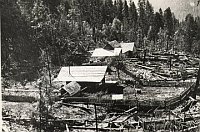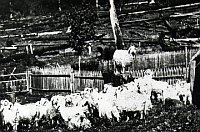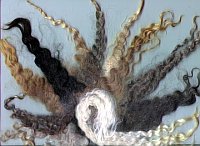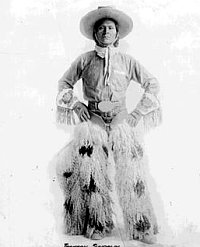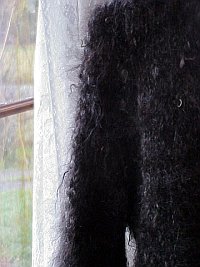Angora Goats ~ Mohair ~ And Us
The history of mohair and angora goats is an ancient one. It is probably one of the most ancient fiber sources known to man. In primitive villages it superseded the killing of animals strictly for their skin for the purpose of clothing. Biblical references to goat hair date to approximately 3,500 years ago during the time of Moses. Indeed, in that context the most sacred of dwellings, the sanctuary of God, had eleven curtains of goat hair as a covering. Here's an ancient text that strikes close to home here at Singing Falls:

"And every man, with whom was found blue, and purple, and scarlet, and fine linen, and goat's hair, and red skins of rams, and badger's skins, brought them... ...And all the women that were wise hearted did spin with their hands, and brought that which they had spun, both of blue, and of purple, and of scarlet, and of fine linen. And all the women whose heart stirred them up in wisdom spun goat's hair."
As the time line of history progresses forward the clarity of the history of mohair and its use also becomes more reliable. Originally the product of Himalayan regions of the near east, the angora goats were supposedly derived from the species Capra aegagrus (the wild Persian goat, Bezoar goat) and then to the subspecies Capra hircus, the domestic goat.
In particular the angora goat is recorded to have been extant to Asia Minor and in particular the Province of Ankara. Some authorities say that the goats were introduced to that region 2500 years ago but the information is not wholly reliable.
Mohair is a silky fiber and is distinct from wool in that it does not have the proliferation microscopic scales that wool is noted for and is therefore much less prone to be a scratchy irritant. In fact mohair very closely approximates human hair on the surface, being very smooth. There are grades of mohair so fine and that they present virtually no ill effect on bare skin.
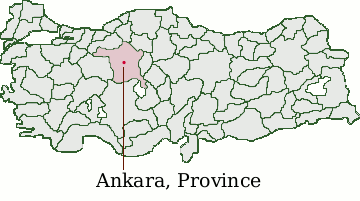
The word mohair is derived from the Arabic mukhayyar ("goat's hair"), which became mockaire in medieval times and had morphed to today's mohair.
Turkey was recorded to have produced distinct types of mohair ranging from ultra fine to semi course in its various provinces. The following is a sampling of the mohair types from the various regions.
Yaban-Ova: A heavy lustrous fleece
Chorba: A mohair fleece so fine that it fell apart as soon as it was shorn from the angora
Chubouk-Ova: Remarkable because of its length and fineness
Ayash: A white lustrous fleece of varying weights
Joevas: Bright and showy but containing some kemp fiber
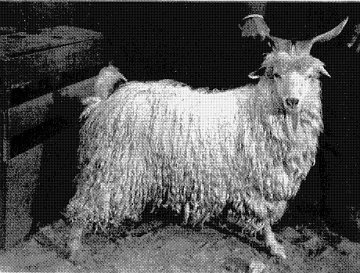
"Old Style"angora goat-Champion Aztec circa 1902 Iowa State
It is not fully understood why the different regions produced such radically different mohair types. Most likely it is associated with the food supply and weather conditions of each area. Here at Singing Falls we have noted a definite relationship with the protein content and the coarseness of fleece. The richer the food supply the more abundant the mohair harvest and the thicker the fiber strands.
Genetics also play a large role in the quality and amount of mohair produced. Fineness of fleece will be affected by food sources but will tend to be finer in individual animals bred for that quality. The finer fleeced angora goats are the prized possession of those desiring a "spinner's flock".
The shepherds of Asia Minor associated the color of the fleece with the soils of the surrounding area. They ascribed the reddish hue found in the mohair of the Konieh region of Turkey to the dark brick red clay soils there. Very similar to some of the clays found here at Singing Falls. This concept has been questioned by the scientific community as a dubious postulation.
Mohair is durable, warm, insulating, and light. It also has moisture wicking properties that carry moisture away from the skin of the wearer.
Europeans imported mohair to there regions beginning in the sixteenth century. Several importations of angoras into the nations west of Asia Minor were met with failure because of the delicacy of the animals. Charles V first brought angora goats to Europe, although the delicacy of the species made mohair difficult to obtain and prohibitively expensive for many. It was introduced into Spain by the Moors, and thence brought into Germany. Only the aristocrat and landlord of that era sported items made of the fiber mohair as a status symbol.
The first imports to the United States took place in 1849. The then Sultan of Turkey bestowed upon the then President Polk, 9 of the finest angora goats of his domain. A second importation took place several years later. These importations are of great significance since the penalty for trying to export angora goats for many centuries was death. Wars in Asia Minor were fought over these precious animals and their fiber.
By the early 1900's angora goats began to proliferate in the United States until the US became the third largest exporter of mohair in the world. The State of Texas was the biggest producer but the West Coast in general had quite a population of angora goats.
It was in the 1800's that angora goats came to the region of South West Oregon where Singing Falls is located. At first the herds were decimated by predators. It was then that a bounty was placed on mountain lions, wolves, coyotes and bears in this region. Then the angora goats flourished. Not long into the "mohair boom days" a pioneer named Lot Jacques moved within walking distance of Singing Falls. He built a beautiful cedar home and enclosed 640 acres of mountain lands surrounding his home with a hand hewn cedar picket fence. Vestiges of that fence remain today and can be seen while hiking in this region.
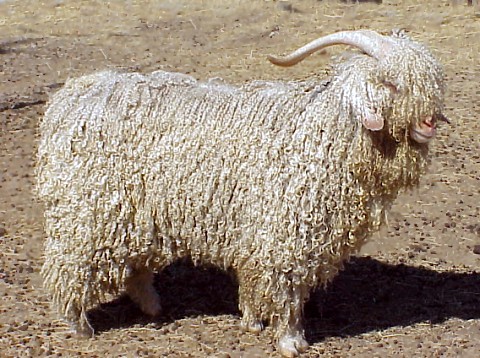
Modern Day Angora Goat buck at Singing Falls
Once Mr. Jacques had his fences up he began shepherding a herd of 200 angora goats. Braided locks from these goats can be found at a small pioneer museum run by a Cow Creek Indian named Charles Jackson here in the Drew area of Tiller, Oregon. Story has it that these extra long braids were sold at top dollar for the making of wigs.
When we settled in this area we didn't realize this little bit of history until some time. Small bands of angoras still remain on scattered ranches in the lower valleys. They are destined to perish since lion hunting has all but been halted.
In the mid 1990's half of our herd was killed by lions two years in a row. These losses were experienced in broad daylight. Seeing the lions was an all too common experience. Predation just about destroyed our cottage industry. At first we had no choice but to destroy the thieving cats. Many long hard hours and sleepless nights were spent dealing with the problem.
But now we have taken a proactive stance on the predator issue by using Livestock Guardian Dogs to protect our band of angoras. They are expensive to keep but a wonderful solution to a serious problem. We have suffered no losses nor have we had to hunt or trap the catamounts for ten years now. The dogs barking gives us sleep at night. The lions leaves us alone. It works!
The saga and terror of the lion attacks we had experienced here at Singing Falls can be read here and here. We are very grateful to have resolved that most traumatic issue.
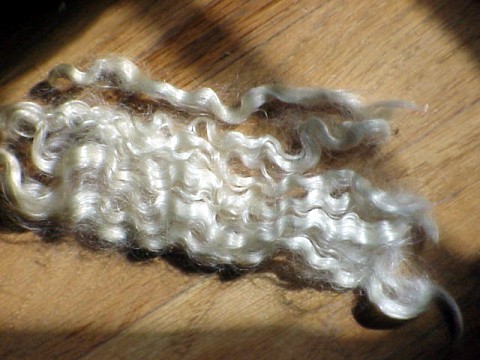
Pure Mohair Locks from Singing Falls
Soon after mohair became so popular a registry of American pure bred angora goats was started. The picture above of Aztec was taken in 1902. At that time angora goats had been bred with common dairy stock to strengthen the blood lines and help the delicate angora goats from Turkey to adapt to their new home. Aztec was the first angora goat of these bloodlines not to have any coarse kemp hair in his fleece. He was the beginning of a new generation of angoras in the US. As herdsmen carefully "bred up" their bands of goats fleece quality improved immensely. Soon competition for the best of breed was a serious proposition. When Aztec won his championship he was sold for $1400 dollars, the highest price paid for an angora goat up to that time. Producing mohair was becoming lucrative and to bring the breed up to its full potential the American Angora Goat Breeders Association (1900) was started. By the 1920's ranchers in Texas alone were raising over 2,000,000 angora goats!
In the last few decades a small but ever growing group of angora goat breeders began a similar process to the one started during the turn of the century. Only this individuals focused on the notion that natural colored mohair had come into its own. There was a growing popular trend in the United States and Europe that centered around an agricultural "organic" lifestyle. Many people began to spurn chemical dyes and appreciated more and more the beautiful natural colors nature produced. During the Summer of 1999 the Colored Angora Goat Breeders Association was formed. Here at Singing Falls we had been breeding for color in 1994. It has been an exciting experience to see goats that were once culled because they showed color in their fleece to now command high prices. Those kids born of purebred herds that are color throwbacks are one of the most coveted animals to those in the registry. There is a tremendous amount of stamina that appears in the goats because of the introduction of new blood. The colored goat fleece quality has reached a very high standard with many of the latest kid crops showing little or no kemp in their fleece at all.
The functional durability of mohair was one of its big selling points. It was able to maintain its brilliant characteristics under adverse conditions. Every train and carriage seat in the world was made of mohair cloth. Seat covers were commonly covered with mohair upholstery. Because mohair took and held dye so easily brilliant colors were applied and the reflective quality of mohair only enhanced it. Vast quantities of mohair were shipped to textile mills around the world. And angora goats multiplied profusely up until the time of the great depression. Following the collapse of the economy the main geographic focus of mohair production in the US was the State of Texas. To be sure mohair production continued here in Oregon also. Vestiges of the angora goat herds remain to this day. The production of synthetic fibers sounded the death knell for many of the large herds in other parts of the US.
In the western United States mohair has played a prominent role in history. Because mohair was warm, durable and aesthetically appealing it was commonly used among the cowboys to protect them from the elements of nature as they rode the range. It was very common to see these rugged and rustic cattlemen saddled on their horses wearing "hairy chaps" (pronounced shaps. Here we have an image of western garb that inculcated the use of mohair. The first image is that of Nez Perce native American Jackson Sundown one of the most famous champion rodeo riders of all time. His chaps are a little dressier in this image than the average cowpoke would have worn. Click on the image of Sundown to view more images of chaps wearing cowpokes.
Anyone who has had an penchant for equestrian interests knows that an essential component to horse tack is the mohair cinch. This item was made of hand-spun mohair and girted that under part of the horse to hold the saddle in place. Very rarely is the mohair cinch made of actual mohair in our time. Nylon has taken the place of mohair because it is strong and cheap to produce compared to mohair. But in its time this particular item could not be surpassed by any other fiber for its strength and functionality. Rope was also made of the coarser grades of mohair in that day.
Today there are many uses for mohair ranging from clothing, blankets, scarves and fiber crafts. Naturally our own little cottage is full of items that we enjoy. Rugs are a common creation for our clients also. Most of our clientele make custom orders to supply their various needs. In recent years hand crafted mohair garments are appearing everywhere. The rich dense texture lends itself to many different styles. The fine arts of knitting and crocheting are once again being discovered. Reborning is another craft that is beginning to bloom at this present time.
We enjoy having our lives filled with the antics of our capricious caprines. And their mohair is flourishing on this land on which we live and learn. Our sense of continuity with the ancient strands of the past is reawakened each day as we mingle with the herd and prepare their fiber for use. We have connectivity with antiquity and the present through them and you, our clients.
If you would like to contribute some anecdotal or scientific information regarding mohair to this page, please feel free to forward it to us.
TOP



